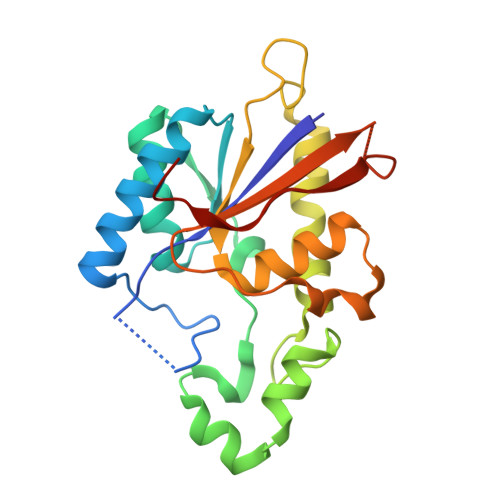Mechanism of dephosphorylation of glucosyl-3-phosphoglycerate by a histidine phosphatase
Zheng, Q., Jiang, D., Zhang, W., Zhang, Q., Zhao, Q., Jin, J., Li, X., Yang, H., Bartlam, M., Shaw, N., Zhou, W., Rao, Z.(2014) J Biological Chem 289: 21242-21251
- PubMed: 24914210
- DOI: https://doi.org/10.1074/jbc.M114.569913
- Primary Citation of Related Structures:
4PZ9, 4PZA, 4QIH - PubMed Abstract:
Mycobacterium tuberculosis (Mtb) synthesizes polymethylated polysaccharides that form complexes with long chain fatty acids. These complexes, referred to as methylglucose lipopolysaccharides (MGLPs), regulate fatty acid biosynthesis in vivo, including biosynthesis of mycolic acids that are essential for building the cell wall. Glucosyl-3-phosphoglycerate phosphatase (GpgP, EC 5.4.2.1), encoded by Rv2419c gene, catalyzes the second step of the pathway for the biosynthesis of MGLPs. The molecular basis for this dephosphorylation is currently not understood. Here, we describe the crystal structures of apo-, vanadate-bound, and phosphate-bound MtbGpgP, depicting unliganded, reaction intermediate mimic, and product-bound views of MtbGpgP, respectively. The enzyme consists of a single domain made up of a central β-sheet flanked by α-helices on either side. The active site is located in a positively charged cleft situated above the central β-sheet. Unambiguous electron density for vanadate covalently bound to His(11), mimicking the phosphohistidine intermediate, was observed. The role of residues interacting with the ligands in catalysis was probed by site-directed mutagenesis. Arg(10), His(11), Asn(17), Gln(23), Arg(60), Glu(84), His(159), and Leu(209) are important for enzymatic activity. Comparison of the structures of MtbGpgP revealed conformational changes in a key loop region connecting β1 with α1. This loop regulates access to the active site. MtbGpgP functions as dimer. L209E mutation resulted in monomeric GpgP, rendering the enzyme incapable of dephosphorylation. The structures of GpgP reported here are the first crystal structures for histidine-phosphatase-type GpgPs. These structures shed light on a key step in biosynthesis of MGLPs that could be targeted for development of anti-tuberculosis therapeutics.
- From the College of Life Sciences, Nankai University, Tianjin 300071, China.
Organizational Affiliation:

















